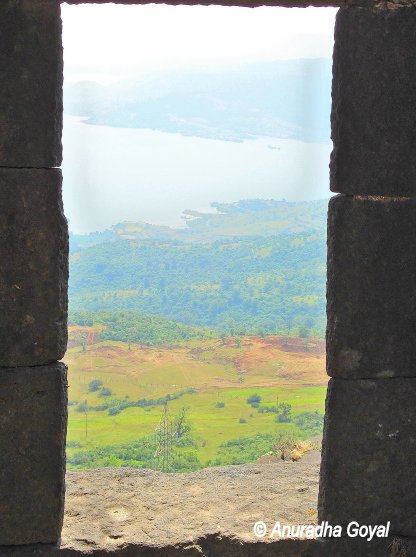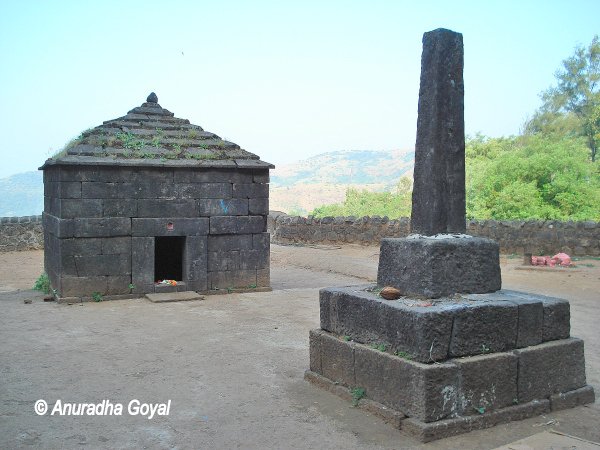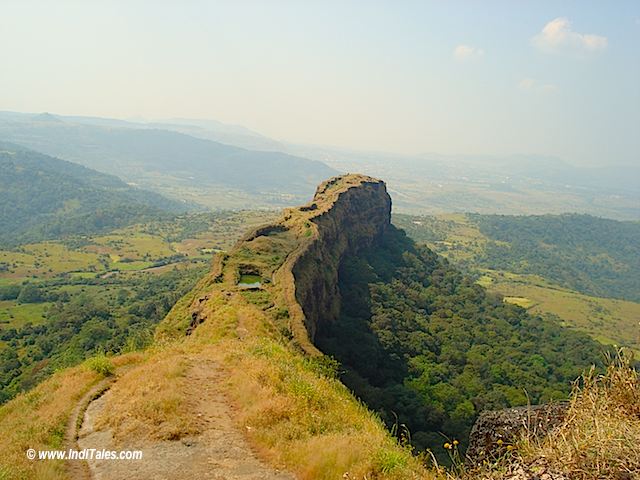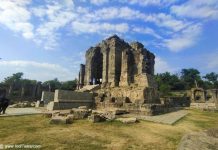Lonavala along with Khandala has been a destination that I have been trying to visit since 1995. When I first came to Pune and lived here for some time. After all these years and multiple visits to Pune, I have managed to fulfill half my wish by visiting Lonavala. I had always heard of these two cities so many times in Hindi movies. Every time I visited either visited Pune or Mumbai, I thought of visiting these very approachable places. But I guess my time to meet these places Lohagad Fort & Karla Caves or Karle Caves had yet not come.

Lohagad Fort, Karla Caves, Ekvira Devi Temple Lonavala

Karla Caves – Places to visit in Lonavala
This Saturday, I along with two other friends drove towards Lonavala, with no specific destination in mind. But with a bountiful of probable destinations in mind, most of which were forts and caves around Lonavala. After a beautiful 1 hour drive on the expressway, we reached the base of Karla Caves. It was still a beautiful morning, and we started climbing the stairs that lead to the Buddhist caves and the Ekvira Devi temple. It is a 20-30 minute climb to the caves, most of which are inaccessible.
History of Karla Caves
Karla Caves fall on the trade route that joins the Arabian Sea to Deccan. There are about 16 caves, out of which the main hall or Chaitya Griha is Cave no 8. This is the only one open to the public as of now. Till some time back, there may be public access to caves on the upper floor that were primarily the viharas and the mandapa, but as of now, the access is closed.
The caves are supposed to date back to the 1st century BCE. There are inscriptions on various walls written in Brahmi giving the names of the donors who contributed to these caves. This includes traders both local and foreign, monks and nuns, and the Satvahana rulers. It was completed by a merchant named Bhutpala, who may have contributed to the final ornamentation of the cave.
Hinayana Style
It is built in the Hinayana style and is said to have Mahayana influence added later on. The largest rock-cut Chaityagriha, known as of now and probably one of the best-preserved. Interestingly this all-stone structure has a wooden structure adorning the roofs. Wood is believed to be a part of the original architecture. It has survived 2300+ years. Besides the main horseshoe-shaped main entrance of the cave, there are two small side entrances. The front is decorated with elaborate sculptures. Stylistically, they may belong to a much later period when Buddha was depicted in human form.
Cave 8 has human as well as animal sculptures including lions and elephants. Most of these are on top of the rows of 15 pillars that line both sides of the Chaitya and meet behind the stupa at the end. Pillars have a square base, an octagonal shaft, and an ornate top. There are elephants carved on top with couples riding them. The pillars behind the Stupa are plain though. Pillars also carry donor details inscribed on them. Stupa at the end of the halls is the focal point of this hall with a well-preserved canopy over it.
You can see a lot of water dripping in front of the caves. You can go around the rock and see a series of caves. They, to me, looked like places where the monks stayed and the main hall was probably where they studied or meditated.

Ekvira Devi Temple
The Ekvira Devi temple just outside the gate of the main hall seems like a relatively recent structure. But today it seems most visitors visit this place for, the temple rather than the caves. It is a usual Hindu temple, which is specially visited on Fridays as that day belongs to the Devi. There are no entrance fees that are charged for that day. The Orange of the temple looks nice against the black stone background of the caves. Since the caves are on a high point, you get a good panoramic view of the surroundings, which have hillocks, greenery, and water bodies.
Bhaja Caves
A few km away from Karla Caves is a small village called Bhaja. The 22 rock-cut caves here called Bhaja caves get their name from the village. From a distance look quite similar to Karla’s caves to a naive eye. Here too a large Chaityagriha or Cave 12 is the main attraction. It resembles the Chaitya at Karla Caves but is a bit smaller.
What makes Bhajja caves different from Karla caves is that sculptures of deities like Surya or Sun and Indra can be seen on the walls here. Another interesting depiction shows the use of the Tabla – a percussion instrument being played, ascertaining its Indian origins.
14 stupas belonging to the different monks can also be seen here.
Trek to Lohagad Fort
From Bhaja village you can trek on a mild gradient toward the base of the Lohagad Fort and Visapur Fort. If the heat of the sun and the tiredness of the long walk drains you, there are a lot of shops selling Lemon juice, Kokum sherbet, Guavas, and Cucumbers. Very close to the base of the fort, there is a series of eating joints most of which offer local food along with water, soft drinks, and juices to rejuvenate you. If you can find a shade below a tree or elsewhere, you will be amazed by the breeze that gently and at times forcefully passes through your skin and your hair and leaves a bundle of energy with you.

Lohagad Fort – Places to visit in Lonavala
There are steep stairs to climb the fort. At various places, the stairs are in various stages of existence. Somewhere they are quite good, somewhere half broken, and at some places, you only find traces of their existence. But one thing that is consistent throughout is the steepness of the stairs, which you realize more while getting down than when you are climbing them up. On the way to the first or the entrance gate of the fort, you would see the beginning of a huge lake. The view of which keeps getting wider as you keep climbing higher.
Ganesh Gate or the first gate
The first gate, also called the Ganesh Gate is the entrance to the fort. There are 2-3 more gates that you see till you reach the vast open space on the top. The fort twists and turns through these gates. There are huge stone walls that are the only remains that tell that there was a fort here sometime. The last gate is the only one which is somewhat preserved. There are caves that have water, and those that have Shivalingas. Some groups apparently camp in the fort sometimes, though I am not sure if this is allowed. There are lime water and cucumber seller, who operates from one of the rooms of the fort.
View from windows of fort walls
Through the windows built into the fort walls, you can see beautiful views of the surroundings. And also feel the strategic location of those holes is like the eye holes in today’s homes. They can show you the slightest movement in the wide-angle view from those small openings, without giving in much of what is happening inside the fort.

Edge of Lohagad Fort
After the last gate, you come to a vast plain ground that has a lot of man-made water tanks in various sizes. Towards the end of this plain area, there is a narrow long strip of the hill, not wider than a few meters that take you to the edge of the hill as well as the fort. As you look at this strip you go through the feeling of standing on top in a very narrow space. An inability to move too much but with a bird’s eye view of everything around you. Is that how you feel when you are at the top?
Lion’s Point
After a two-hour walk back to the Bhaja village, we proceeded to Lonavala to satisfy our hunger pangs. Then quickly drove to Lion’s Point to see the sunset. Little did I know this was going to be one of the best times of a day well spent. There is a hill in the middle of the valley, called Lion Hill and this is how this place gets the name. But if you look closely at the top of the hill, you would be able to see faces carved in stone. One of which has a good resemblance to Shivaji. If you could go to another side of the hill and look at a different angle maybe you can also see the third face.
Sunset view
The sunset could have been more beautiful but for the clouds who decided to play hide and seek with the sun. The place was very peaceful and yet enigmatic. Something that said, be here, do not go anywhere…
Highly recommend all these places to anyone who likes history and nature. That too when the two are intermingling with each other.
Recommend you to read the following Travel Blog on Tourist Places in Maharashtra to explore.
Amboli Ghat – Kingdom of Waterfalls in the Western Ghats
Thoseghar Falls – Waterfalls of Satara













Once again , a lovely piece on a little known place. A teat for real travellers.
The experience is awesome. But according to me, motorbike would be more feasible rather than car because driving motorbike at this kind of place is easier than car. In 2013, I had visited Lonavala with my friends by bike and believe me that experience was mind – blowing. If you do not own a bike then you can hire on rent.
Chintu, While I agree with you that the route is better suited for motorbikes, I also know that not everyone is comfortable driving motorbikes.
That’s a point! Thank you ma’am!
We are again planning for Lonavala this rainy season. This time we are planning by Royal Enfield. I do not own RE, so I would be hiring it. Is there any place in Pune where I can get a bike on rent?
Once again thank you so much ma’am for sharing your experience!
dear mam
the temple shown is not AAI EKVIRA TEMPLE.
Dear Yogesh, can you please tell me the name of the temple, will update it.
These are the places you can visit any time of the year specially Monsoon season you will have fantastic time. These places are mid way of PUNe and Mumbai.